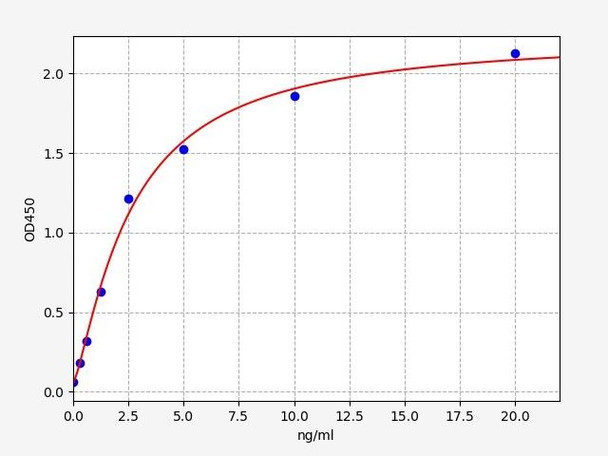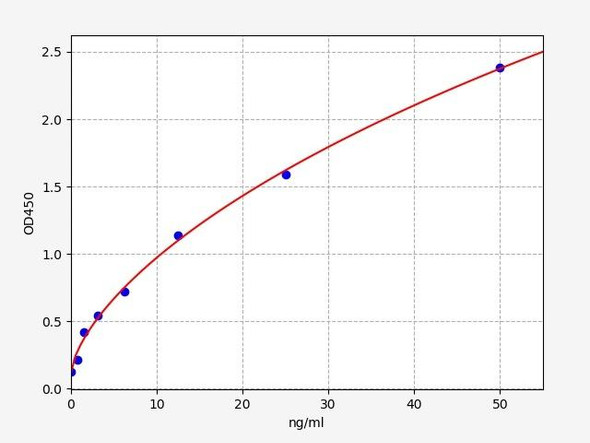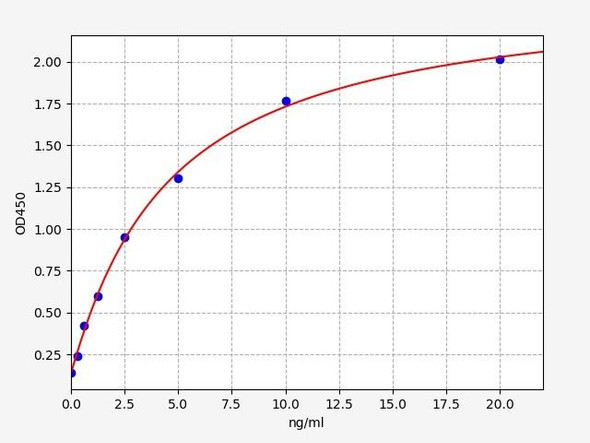Rat Immunology ELISA Kits 1
Rat ACE / Angiotensin Converting Enzyme 1 ELISA Kit
- SKU:
- RTFI00069
- Product Type:
- ELISA Kit
- Size:
- 96 Assays
- Uniprot:
- P47820
- Sensitivity:
- 0.188ng/ml
- Range:
- 0.313-20ng/ml
- ELISA Type:
- Sandwich
- Synonyms:
- ACE, CD143, DCP1, Kininase II, ACE1angiotensin converting enzyme, somatic isoform, angiotensin I converting enzyme, peptidyl-dipeptidase A 1, carboxycathepsin, CD143, CD143 antigen, DCP, DCP1angiotensin-converting enzyme, dipeptidyl carboxypeptidase
- Reactivity:
- Rat
Description
| Product Name: | Rat Ace (Angiotensin-converting enzyme) ELISA Kit |
| Product Code: | RTFI00069 |
| Size: | 96 Assays |
| Target: | Rat Ace |
| Alias: | ACE, CD143, DCP1, Kininase II, ACE1angiotensin converting enzyme, somatic isoform, angiotensin I converting enzyme, peptidyl-dipeptidase A 1, carboxycathepsin, CD143, CD143 antigen, DCP, DCP1angiotensin-converting enzyme, dipeptidyl carboxypeptidase 1, Dipeptidyl carboxypeptidase I, Kininase II, MVCD3, peptidase P, testicular ECA |
| Reactivity: | Rat |
| Detection Method: | Sandwich ELISA, Double Antibody |
| Sensitivity: | 0.188ng/ml |
| Range: | 0.313-20ng/ml |
| Storage: | 4°C for 6 months |
| Note: | For Research Use Only |
| Recovery: | Matrices listed below were spiked with certain level of Rat Ace and the recovery rates were calculated by comparing the measured value to the expected amount of Rat Ace in samples. | ||||||||||||||||
| |||||||||||||||||
| Linearity: | The linearity of the kit was assayed by testing samples spiked with appropriate concentration of Rat Ace and their serial dilutions. The results were demonstrated by the percentage of calculated concentration to the expected. | ||||||||||||||||
| |||||||||||||||||
| Intra-Assay: | CV <8% | ||||||||||||||||
| Inter-Assay: | CV <10% |
| Uniprot: | P47820 |
| UniProt Protein Function: | ACE: Converts angiotensin I to angiotensin II by release of the terminal His-Leu, this results in an increase of the vasoconstrictor activity of angiotensin. Also able to inactivate bradykinin, a potent vasodilator. Has also a glycosidase activity which releases GPI-anchored proteins from the membrane by cleaving the mannose linkage in the GPI moiety. Genetic variations in ACE may be a cause of susceptibility to ischemic stroke (ISCHSTR); also known as cerebrovascular accident or cerebral infarction. A stroke is an acute neurologic event leading to death of neural tissue of the brain and resulting in loss of motor, sensory and/or cognitive function. Ischemic strokes, resulting from vascular occlusion, is considered to be a highly complex disease consisting of a group of heterogeneous disorders with multiple genetic and environmental risk factors. Defects in ACE are a cause of renal tubular dysgenesis (RTD). RTD is an autosomal recessive severe disorder of renal tubular development characterized by persistent fetal anuria and perinatal death, probably due to pulmonary hypoplasia from early-onset oligohydramnios (the Potter phenotype). Genetic variations in ACE are associated with susceptibility to microvascular complications of diabetes type 3 (MVCD3). These are pathological conditions that develop in numerous tissues and organs as a consequence of diabetes mellitus. They include diabetic retinopathy, diabetic nephropathy leading to end-stage renal disease, and diabetic neuropathy. Diabetic retinopathy remains the major cause of new- onset blindness among diabetic adults. It is characterized by vascular permeability and increased tissue ischemia and angiogenesis. Defects in ACE are a cause of susceptibility to intracerebral hemorrhage (ICH). A pathological condition characterized by bleeding into one or both cerebral hemispheres including the basal ganglia and the cerebral cortex. It is often associated with hypertension and craniocerebral trauma. Intracerebral bleeding is a common cause of stroke. Belongs to the peptidase M2 family. 4 isoforms of the human protein are produced by alternative splicing. |
| UniProt Protein Details: | Protein type:Membrane protein, integral; EC 3.4.15.1; Protease Cellular Component: basal plasma membrane; brush border membrane; cytoplasm; endosome; external side of plasma membrane; extracellular space; integral to membrane; lysosome; plasma membrane; vesicle Molecular Function:actin binding; bradykinin receptor binding; carboxypeptidase activity; chloride ion binding; drug binding; endopeptidase activity; exopeptidase activity; metal ion binding; metallopeptidase activity; mitogen-activated protein kinase binding; mitogen-activated protein kinase kinase binding; peptidase activity; peptidyl-dipeptidase activity; tripeptidyl-peptidase activity; zinc ion binding Biological Process: aging; alveolus development; arachidonic acid secretion; beta-amyloid metabolic process; brain development; eating behavior; female pregnancy; heart contraction; hormone catabolic process; kidney development; lung development; male gonad development; negative regulation of protein binding; neutrophil mediated immunity; organ regeneration; peptide catabolic process; peptide metabolic process; positive regulation of apoptosis; positive regulation of inflammatory response; positive regulation of neurogenesis; positive regulation of protein binding; positive regulation of systemic arterial blood pressure; proteolysis; regulation of angiotensin metabolic process; regulation of blood pressure; regulation of smooth muscle cell migration; regulation of systemic arterial blood pressure by renin-angiotensin; response to drug; response to hypoxia; response to lipopolysaccharide; response to nutrient levels; sensory perception of pain; spermatogenesis; vasoconstriction |
| NCBI Summary: | catalyzes the conversion of angiotensin I to angiotensin II; plays a role in regulation of blood pressure [RGD, Feb 2006] |
| UniProt Code: | P47820 |
| NCBI GenInfo Identifier: | 6978757 |
| NCBI Gene ID: | 24310 |
| NCBI Accession: | NP_036676.1 |
| UniProt Related Accession: | P47820 |
| Molecular Weight: | |
| NCBI Full Name: | angiotensin-converting enzyme |
| NCBI Synonym Full Names: | angiotensin I converting enzyme |
| NCBI Official Symbol: | Ace |
| NCBI Official Synonym Symbols: | Dcp1; CD143; StsRR92 |
| NCBI Protein Information: | angiotensin-converting enzyme |
| UniProt Protein Name: | Angiotensin-converting enzyme |
| UniProt Synonym Protein Names: | Dipeptidyl carboxypeptidase I; Kininase II; CD_antigen: CD143 |
| Protein Family: | Acetylcholinesterase |
| UniProt Gene Name: | Ace |
| UniProt Entry Name: | ACE_RAT |
| Step | Procedure |
| 1. | Set standard, test sample and control (zero) wells on the pre-coated plate respectively, and then, record their positions. It is recommended to measure each standard and sample in duplicate. Wash plate 2 times before adding standard, sample and control (zero) wells! |
| 2. | Aliquot 0.1ml standard solutions into the standard wells. |
| 3. | Add 0.1 ml of Sample / Standard dilution buffer into the control (zero) well. |
| 4. | Add 0.1 ml of properly diluted sample ( Human serum, plasma, tissue homogenates and other biological fluids.) into test sample wells. |
| 5. | Seal the plate with a cover and incubate at 37°C for 90 min. |
| 6. | Remove the cover and discard the plate content, clap the plate on the absorbent filter papers or other absorbent material. Do NOT let the wells completely dry at any time. Wash plate X2. |
| 7. | Add 0.1 ml of Biotin- detection antibody working solution into the above wells (standard, test sample & zero wells). Add the solution at the bottom of each well without touching the side wall. |
| 8. | Seal the plate with a cover and incubate at 37°C for 60 min. |
| 9. | Remove the cover, and wash plate 3 times with Wash buffer. Let wash buffer rest in wells for 1 min between each wash. |
| 10. | Add 0.1 ml of SABC working solution into each well, cover the plate and incubate at 37°C for 30 min. |
| 11. | Remove the cover and wash plate 5 times with Wash buffer, and each time let the wash buffer stay in the wells for 1-2 min. |
| 12. | Add 90 µL of TMB substrate into each well, cover the plate and incubate at 37°C in dark within 10-20 min. (Note: This incubation time is for reference use only, the optimal time should be determined by end user.) And the shades of blue can be seen in the first 3-4 wells (with most concentrated standard solutions), the other wells show no obvious color. |
| 13. | Add 50 µL of Stop solution into each well and mix thoroughly. The color changes into yellow immediately. |
| 14. | Read the O.D. absorbance at 450 nm in a microplate reader immediately after adding the stop solution. |
When carrying out an ELISA assay it is important to prepare your samples in order to achieve the best possible results. Below we have a list of procedures for the preparation of samples for different sample types.
| Sample Type | Protocol |
| Serum: | If using serum separator tubes, allow samples to clot for 30 minutes at room temperature. Centrifuge for 10 minutes at 1,000x g. Collect the serum fraction and assay promptly or aliquot and store the samples at -80°C. Avoid multiple freeze-thaw cycles. If serum separator tubes are not being used, allow samples to clotovernight at 2-8°C. Centrifuge for 10 minutes at 1,000x g. Removeserum and assay promptly or aliquot and store the samples at-80°C. Avoid multiple freeze-thaw cycles. |
| Plasma: | Collect plasma using EDTA or heparin as an anti-coagulant. Centrifuge samples at 4°C for 15 mins at 1000 × g within 30 mins of collection. Collect the plasma fraction and assay promptly or aliquot and store the samples at -80°C. Avoid multiple freeze-thaw cycles.Note: Over haemolysed samples are not suitable for use with this kit. |
| Urine & Cerebrospinal Fluid: | Collect the urine (mid-stream) in a sterile container, centrifuge for 20 mins at 2000-3000 rpm. Remove supernatant and assay immediately. If any precipitation is detected, repeat the centrifugation step. A similar protocol can be used for cerebrospinal fluid. |
| Cell Culture Supernatant: | Collect the cell culture media by pipette, followed by centrifugation at 4°C for 20 mins at 1500 rpm. Collect the clear supernatant and assay immediately. |
| Cell Lysates: | Solubilize cells in lysis buffer and allow to sit on ice for 30 minutes. Centrifuge tubes at 14,000 x g for 5 minutes to remove insoluble material. Aliquot the supernatant into a new tube and discard the remaining whole cell extract. Quantify total protein concentration using a total protein assay. Assay immediately or aliquot and store at ≤ -20°C. |
| Tissue Homogenates: | The preparation of tissue homogenates will vary depending upon tissue type. Rinse tissue with 1X PBS to remove excess blood & homogenizein 20ml of 1X PBS (including protease inhibitors) and store overnight at ≤ -20°C. Two freeze-thaw cycles are required to break the cell membranes. To further disrupt the cell membranes you can sonicate the samples. Centrifuge homogenates for 5 mins at 5000xg. Remove the supernatant and assay immediately or aliquot and store at -20°C or-80°C. |
| Tissue Lysates: | Rinse tissue with PBS, cut into 1-2 mm pieces, and homogenize with a tissue homogenizer in PBS. Add an equal volume of RIPA buffer containing protease inhibitors and lyse tissues at room temperature for 30 minutes with gentle agitation. Centrifuge to remove debris. Quantify total protein concentration using a total protein assay. Assay immediately or aliquot and store at ≤ -20 °C. |
| Breast Milk: | Collect milk samples and centrifuge at 10,000 x g for 60 min at 4°C. Aliquot the supernatant and assay. For long term use, store samples at -80°C. Minimize freeze/thaw cycles. |






